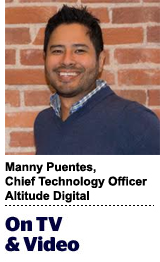 “On TV And Video” is a column exploring opportunities and challenges in programmatic TV and video.
“On TV And Video” is a column exploring opportunities and challenges in programmatic TV and video.
Today’s column is written by Manny Puentes, chief technology officer at Altitude Digital.
Following the industry’s adoption of viewability as a core metric, even moving toward transacting on vCPM, advertisers are now eyeing other measures that can tell them more about which factors ultimately drive engagement and conversions.
With video advertising gaining traction on Facebook and Twitter, the muting-by-default behavior on these platforms has advertisers starting to ask about audibility – whether an ad was heard and for how long.
Group M, well known for its strict viewability requirements, already requires sound on for its video campaigns, and Pandora recently announced plans to test audio-based ad measurement.
As audibility enters the conversation in a bigger way, publishers need to stay ahead of the curve and understand and measure the metric on their own sites so they can be well prepared to transact on it when the time comes.
Challenges To Measurement
The MRC hasn’t officially created any standard around audibility because traditionally it has been difficult to measure the different ways an advertisement can be muted. Accurately assessing whether someone can hear an ad requires checks at the video file, player and device levels. MRC has delayed setting a standard until the technology to more accurately measure these scenarios is in place.
That has left the onus on verification companies to build that technology and push the conversation forward. Moat measures audibility based on audio checks at the creative and player level, and Google has announced plans to eventually report on audibility across its video advertising products. As more players come to the table with proven measurement technologies, the MRC won’t be far behind in creating official guidelines.
The Sound-Off
Publishers and platforms alike tend to prefer muted-by-default behavior for their video to avoid disrupting users. As video grows in popularity, however, advertisers will no doubt begin looking at how audio impacts overall engagement. They will expect their ads to be heard, not just seen.
Publishers should begin by measuring and understanding their overall audibility rates and how they correlate with other metrics, such as viewability and even fraud. Although bots are successfully mimicking viewability, high audibility may be correlated to lower rates of fraud.
Once publishers have a grasp on their overall audibility, they can begin to package their inventory with these type of value-added metrics that show how their audiences are truly engaging with video on their sites.
A Matter Of Metrics
Most publishers were reactive to meeting the more stringent MRC-sanctioned viewability requirements pushed last year and responded by adjusting layouts, implementing expensive redesigns and installing new measurement technologies.
As audibility comes into focus, publishers now have the ability to get ahead of the curve and use it and other below-the-radar engagement metrics as a position of strength to more successfully package and promote their video inventory.
Follow Manny Puentes (@epuentes), Altitude Digital (@AltitudeDP) and AdExchanger (@adexchanger) on Twitter.











